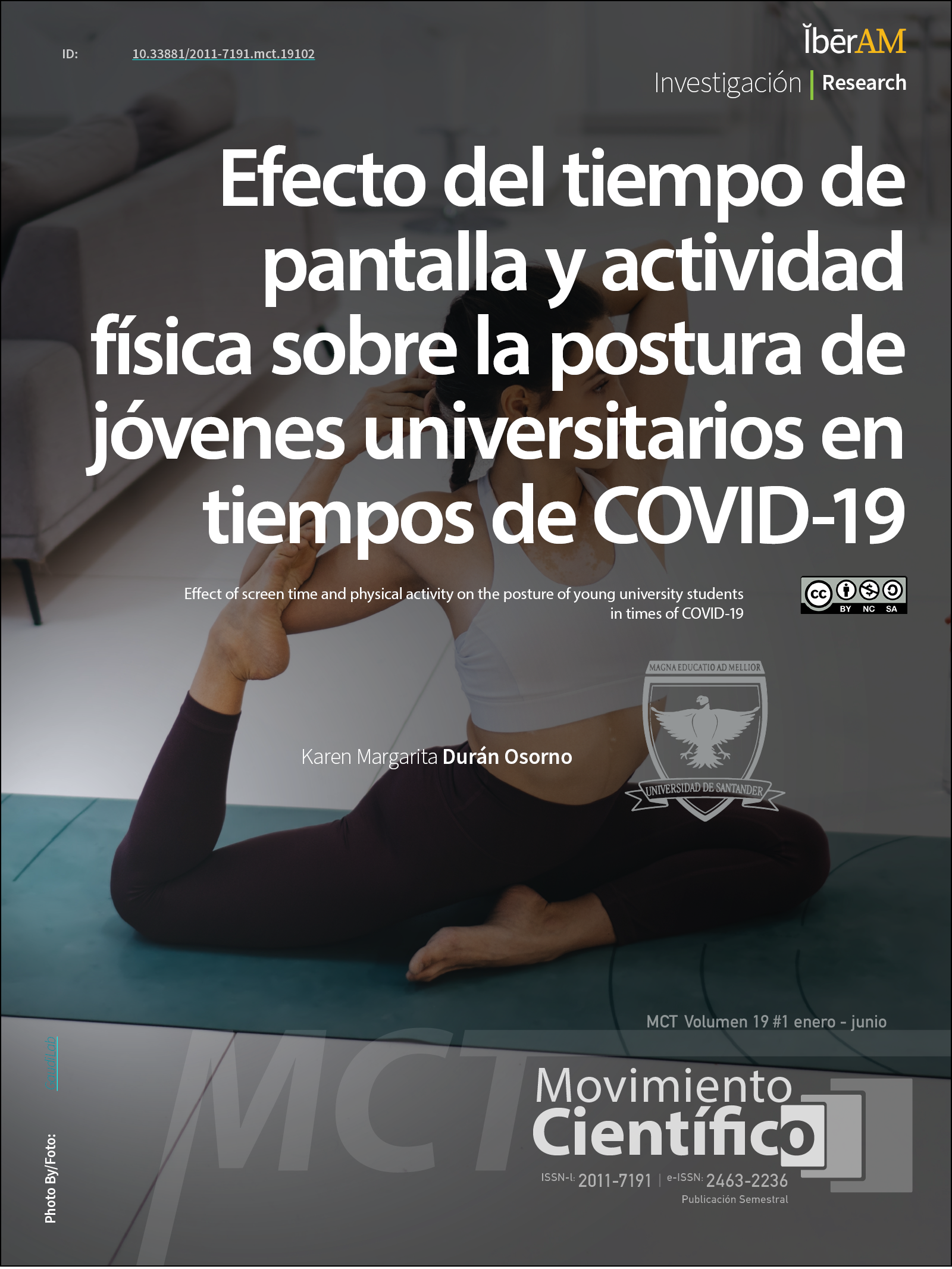Efecto del tiempo de pantalla y actividad física sobre la postura de jóvenes universitarios en tiempos de COVID-19
The effect of screen time and physical activity on the posture of young university students during the COVID-19 pandemic.
Contenido principal del artículo
Introducción: Se estima que una proporción importante de los jóvenes estudiantes universitarios entre 17 y 22 años presenta alguna alteración postural, así como conductas sedentarias relacionadas con el uso de las pantallas, lo que ha conllevado a niveles de actividad física cada vez más bajos en esta población, especialmente en etapas iniciales del COVID-19. El objetivo de esta investigación fue analizar el efecto que el tiempo de pantalla y nivel de actividad física tiene sobre la postura corporal en estudiantes universitarios en condición de aislamiento preventivo por COVID-19. Materiales y Métodos: Estudio de tipo cuantitativo, con diseño observacional, transversal analítico, en el cual participaron 67 estudiantes universitarios entre 18 y 23 años. Fueron evaluados mediante los cuestionarios Television and Video Mesures (TVM), el Cuestionario Mundial sobre Actividad Física (GPAQ) y posturografía a través del software SAPO versión Beta 0.69. Resultados: El 98,51% de los estudiantes presentó un bajo nivel de actividad física, las pantallas más utilizadas fueron el teléfono inteligente (35,85±18,96 hrs) y el computador (24,84±18,20 hrs); Se evidenció una correlación débil entre el uso del teléfono inteligente y el computador con la alineación longitudinal de miembros inferiores, no se hallaron diferencias significativas en la alineación postural con respecto practicar o no algún tipo de actividad física, pero si en el uso diario y semanal del televisor. Conclusión: El tiempo pantalla y la práctica o no de actividad física generan un efecto significativo sobre la alineación de tuberosidades tibiales y el ángulo pierna retropié en la muestra estudiada.
Descargas
Datos de publicación
Perfil evaluadores/as N/D
Declaraciones de autoría
Indexado en
-
—
- Sociedad académica
- N/D
- Editorial
- Bogotá: Corporación Universitaria Iberoamericana
Detalles del artículo
Abdel-Aziem, A. A., Abdel-Ghafar, M. A. F., Ali, O. I., & Abdelraouf, O. R. (2022). Effects of smartphone screen viewing duration and body position on head and neck posture in elementary school children. Journal of Back and Musculoskeletal Rehabilitation, 35(1), 185–193. https://doi.org/10.3233/BMR-200334/ASSET/IMAGES/LARGE/10.3233_BMR-200334-FIG1.JPEG DOI: https://doi.org/10.3233/BMR-200334
Álvarez Cadena, K. A., Mora Alvarado, K. G., Pilamunga Asacata, D. E., & Naranjo Kean Chong, M. K. (2020). Tiempo en pantalla (televisión, computadora, celular, tabletas) en las relaciones interpersonales entre niños de 8 a 12 años. Revista de Investigación En Ciencias de La Educación, 4(15), 258–266. DOI: https://doi.org/10.33996/revistahorizontes.v4i15.113
Arango-Vélez, E. F., Echavarría-Rodríguez, A. M., Aguilar-González, F. A., & Patiño-Villada, F. A. (2020). Validation of two questionnaires to assess the level of physical activity and sedentary time in a Colombian university community. Revista Facultad Nacional de Salud Publica, 38(1). https://doi.org/10.17533/udea.rfnsp.v38n1e334156 DOI: https://doi.org/10.17533/udea.rfnsp.v38n1e334156
Braz, R. G., Goes, F. P. D. C., & Carvalho, G. A. (2017). CONFIABILIDADE E VALIDADE DE MEDIDAS ANGULARES POR MEIO DO SOFTWARE PARA AVALIAÇÃO POSTURAL. Fisioterapia Em Movimento (Physical Therapy in Movement), 21(3). https://periodicos.pucpr.br/fisio/article/view/19185
Bringué, X., & Sádaba, C. (2008). LA GENERACIÓN INTERACTIVA EN IBEROAMÉRICA Niños y adolescentes ante las pantallas. In Colección Fundación Telefónica, Ariel. Barcelona. https://hdl.handle.net/10171/7307
Buñay-Yasaca, L. A., Chiriboga-Larrea, G. A., Vega-Falcón, V., & Lana-Cisneros, J. E. (2022). Estimación de trastornos musculoesqueléticos por uso de pantallas en trabajadores de una empresa aseguradora. Revista Arbitrada Interdisciplinaria de Ciencias de La Salud. Salud y Vida, 6(2), 268–275. https://doi.org/10.35381/s.v.v6i2.2093 DOI: https://doi.org/10.35381/s.v.v6i2.2093
Castro, L., Gómez, V., & Landívar, R. (2018). Prevalencia de alteraciones posturales de la columna vertebral, asociada al carente hábito deportivo, en jóvenes de 17 a 22 años de edad abril-junio del 2017. Revista Medica La Paz, 24(2), 18–23.
Chastin, S. F., Mandrichenko, O., & Skelton, D. A. (2014). The frequency of osteogenic activities and the pattern of intermittence between periods of physical activity and sedentary behaviour affects bone mineral content: The cross-sectional NHANES study. BMC Public Health, 14(1). https://doi.org/10.1186/1471-2458-14-4 DOI: https://doi.org/10.1186/1471-2458-14-4
Devi, K. A., & Singh, S. K. (2023). The hazards of excessive screen time: Impacts on physical health, mental health, and overall well‑being. Journal of Education and Health Promotion, 12(1). https://doi.org/10.4103/JEHP.JEHP_447_23 DOI: https://doi.org/10.4103/jehp.jehp_447_23
Ferreira, E. A. G., Duarte, M., Maldonado, E. P., Burke, T. N., & Marques, A. P. (2010). Postural Assessment Software (PAS/SAPO): Validation and Reliabiliy. Clinics, 65(7), 675–681. https://doi.org/10.1590/S1807-59322010000700005 DOI: https://doi.org/10.1590/S1807-59322010000700005
Forero, G. A., Sala, X. B., & Chalezquer, C. S. (2010). La generación interactiva en Colombia: adolescentes frente a la Internet, el celular y los videojuegos. Anagramas Rumbos Sentidos Comun. https://revistas.udem.edu.co/index.php/anagramas/article/view/464/417
González-Menéndez, E., López-González, J., González Menéndez, S., García González, G., & Álvarez Bayona, T. (2019). COLABORACIÓN ESPECIAL PRINCIPALES CONSECUENCIAS PARA LA SALUD DERIVADAS DEL USO CONTINUADO DE NUEVOS DISPOSITIVOS ELECTRÓNICOS CON PVD. Rev Esp Salud Pública, 93, 30–31. www.msc.es/resp
Hodelín, Y. H., Luz De Los, Z., García, R., Cumbá, G. H., & Salmon, M. B. (2016). Riesgos sobre tiempo prolongado frente a un ordenador. Revista Información Científica, ISSN-e 1028-9933, Vol. 95, No. 1, 2016, Págs. 175-190, 95(1), 175–190. https://dialnet.unirioja.es/servlet/articulo?codigo=6027406&info=resumen&idioma=ENG
Hurtado, A. F. V., Ramos, O. A., Jácome, S. J., & Cabrera, M. del M. M. (2020). Actividad física y ejercicio en tiempos de COVID-19. CES Medicina, 34, 51–58. https://doi.org/10.21615/CESMEDICINA.34.COVID-19.6 DOI: https://doi.org/10.21615/cesmedicina.34.COVID-19.6
INSST. (2020). Riesgos ergonómicos en el uso de las nuevas tecnologías con pantallas de visualización. Nota Técnica de Prevención 1150, 1–5. https://www.insst.es/documents/94886/566858/NTP+1150+Riesgos+ergonómicos+en+el+uso+de+las+nuevas+tecnologías+con+pantallas+de+visualización+-+Año+2020.pdf/0ce76d93-5654-ae2f-2951-1918026c5133?version=2.0&t=1614878622461
Koedijk, J. B., van Rijswijk, J., Oranje, W. A., van den Bergh, J. P., Bours, S. P., Savelberg, H. H., & Schaper, N. C. (2017). Sedentary behaviour and bone health in children, adolescents and young adults: a systematic review–supplementary presentation. Osteoporosis International, 28(10), 3075–3076. https://doi.org/10.1007/s00198-017-4195-9 DOI: https://doi.org/10.1007/s00198-017-4195-9
Martí Trujillo, S. (2011). Actividad física, sedentarismo frente a pantallas y su relación en adolescentes [Universidad de Las Palmas de Gran Canaria]. https://accedacris.ulpgc.es/bitstream/10553/9810/4/0665819_00000_0000.pdf
Nanjarí-Miranda, R., Aranda-Bustamante, F., Saavedra-León, V., Zuñiga-Vivanco, J., Castillo-Paredes, A., Yáñez-Sepúlveda, R., & Olivares-Arancibia, J. (2024). Higiene postural: factores que influyen en una correcta postura en niños y adolescentes. Una revisión sistemática (Postural hygiene: factors that influence correct posture in children and adolescents. A systematic re-view). Retos, 56, 374–384. https://doi.org/10.47197/RETOS.V56.96405 DOI: https://doi.org/10.47197/retos.v56.96405
Navarrete, H. P. (2023). Relación entre tiempo frente a pantalla y actividad física en adolescentes. REVISTA CHILENA DE REHABILITACIÓN Y ACTIVIDAD FÍSICA. https://revistas.uautonoma.cl/index.php/reaf/article/view/2081/1423 DOI: https://doi.org/10.32457/reaf2.2081
Nguyen, P., Le, L. K. D., Nguyen, D., Gao, L., Dunstan, D. W., & Moodie, M. (2020). The effectiveness of sedentary behaviour interventions on sitting time and screen time in children and adults: An umbrella review of systematic reviews. International Journal of Behavioral Nutrition and Physical Activity, 17(1), 1–11. https://doi.org/10.1186/S12966-020-01009-3/TABLES/2 DOI: https://doi.org/10.1186/s12966-020-01009-3
Rivera, P. A., Nys, B. L., & Fiestas, F. (2021). Impact of COVID-19 induced lockdown on physical activity and sedentary behavior among university students: A systematic review. Medwave, 21(8). https://doi.org/10.5867/MEDWAVE.2021.08.8456 DOI: https://doi.org/10.5867/medwave.2021.08.8456
Rodríguez-Cáceres, A., Alejandra Sánchez-Vera, M., Alfonso-Mora, M., Sarmiento-Gonzalez, P., Lever Méndez, J., Milena, A., Becerra, G., Guerra-Balic, M., & Sánchez-Martin, R. (2023). Relación entre la exposición a pantallas, el comportamiento sedentario y el dolor musculoesquelético en adolescentes: revisión sistemática. Retos: Nuevas Tendencias En Educación Física, Deporte y Recreación, ISSN-e 1988-2041, ISSN 1579-1726, No. 50, 2023, Págs. 1064-1070, 50(50), 1064–1070. https://dialnet.unirioja.es/servlet/articulo?codigo=9080274&info=resumen&idioma=ENG DOI: https://doi.org/10.47197/retos.v50.99865
Rubio-Tomás, T., Skouroliakou, M., & Ntountaniotis, D. (2022). Lockdown Due to COVID-19 and Its Consequences on Diet, Physical Activity, Lifestyle, and Other Aspects of Daily Life Worldwide: A Narrative Review. International Journal of Environmental Research and Public Health, 19(11), 6832. https://doi.org/10.3390/IJERPH19116832 DOI: https://doi.org/10.3390/ijerph19116832
Sadarangani, K. P., De Roia, G. F., Lobo, P., Chavez, R., Meyer, J., Cristi-Montero, C., Martinez-Gomez, D., Ferrari, G., Schuch, F. B., Gil-Salmerón, A., Solmi, M., Veronese, N., Alzahrani, H., Grabovac, I., Caperchione, C. M., Tully, M. A., & Smith, L. (2021). Changes in sitting time, screen exposure and physical activity during covid-19 lockdown in south american adults: A cross-sectional study. International Journal of Environmental Research and Public Health, 18(10). https://doi.org/10.3390/ijerph18105239 DOI: https://doi.org/10.3390/ijerph18105239
Sadarangani, K. P., Schuch, F. B., De Roia, G., Martínez-Gomez, D., Chávez, R., Lobo, P., Cristi-Montero, C., Werneck, A. O., Alzahrani, H., Ferrari, G., Ibanez, A., Silva, D. R., Von Oetinger, A., Matias, T. S., Grabovac, I., & Meyer, J. (2023). Exchanging screen for non-screen sitting time or physical activity might attenuate depression and anxiety: A cross-sectional isotemporal analysis during early pandemics in South America. Journal of Science and Medicine in Sport, 26(6), 309–315. https://doi.org/10.1016/j.jsams.2023.04.007 DOI: https://doi.org/10.1016/j.jsams.2023.04.007
Saunders, T., & Colley, R. C. (2024). Regional trends in the moderate-to-vigorous intensity physical activity and screen time of Canadians before and during the COVID-19 pandemic. PeerJ, 12, 1–27. https://doi.org/10.7717/peerj.16913 DOI: https://doi.org/10.7717/peerj.16913
Sengsoon, P., & Siriworakunsak, K. (2023). A comparison of muscle activity, posture and body discomfort during the use of different computer screen sizes. International Journal of Occupational Safety and Ergonomics : JOSE, 29(1), 424–430. https://doi.org/10.1080/10803548.2022.2054543 DOI: https://doi.org/10.1080/10803548.2022.2054543
Tandon, P. S., Zhou, C., Johnson, A. M., Gonzalez, E. S., & Kroshus, E. (2021). Association of Children’s Physical Activity and Screen Time With Mental Health During the COVID-19 Pandemic. JAMA Network Open, 4(10), e2127892. https://doi.org/10.1001/JAMANETWORKOPEN.2021.27892 DOI: https://doi.org/10.1001/jamanetworkopen.2021.27892
Werneck, A. O., Vancampfort, D., Oyeyemi, A. L., Stubbs, B., & Silva, D. R. (2018). Associations between TV viewing, sitting time, physical activity and insomnia among 100,839 Brazilian adolescents. Psychiatry Research, 269, 700–706. https://doi.org/10.1016/J.PSYCHRES.2018.08.101 DOI: https://doi.org/10.1016/j.psychres.2018.08.101
Wunsch, K., Kienberger, K., & Niessner, C. (2022). Changes in Physical Activity Patterns Due to the COVID-19 Pandemic: A Systematic Review and Meta-Analysis. International Journal of Environmental Research and Public Health, 19(4), 2250. https://doi.org/10.3390/IJERPH19042250/S1 DOI: https://doi.org/10.3390/ijerph19042250
Yaşarer, Ö., Mete, E., Kaygusuz Benli, R., Kılıç, B. B., Doğan, H., & Sarı, Z. (2024). Association between smartphone addiction and myofascial trigger points. BMC Musculoskeletal Disorders, 25(1), 1–9. https://doi.org/10.1186/S12891-024-07383-4/TABLES/2 DOI: https://doi.org/10.1186/s12891-024-07383-4
Zamarripa, J., Marroquín-Zepeda, S. D., Ceballos-Gurrola, O., Flores-Allende, G., & García-Gallegos, J. B. (2021). Nivel de actividad física y conductas sedentarias antes y durante el confinamiento a causa del COVID-19 en adultos mexicanos (Level of physical activity and sedentary behaviors before and during confinement due to COVID-19 in Mexican adults). Retos, 42, 898–905. https://doi.org/10.47197/RETOS.V42I0.87278 DOI: https://doi.org/10.47197/retos.v42i0.87278














